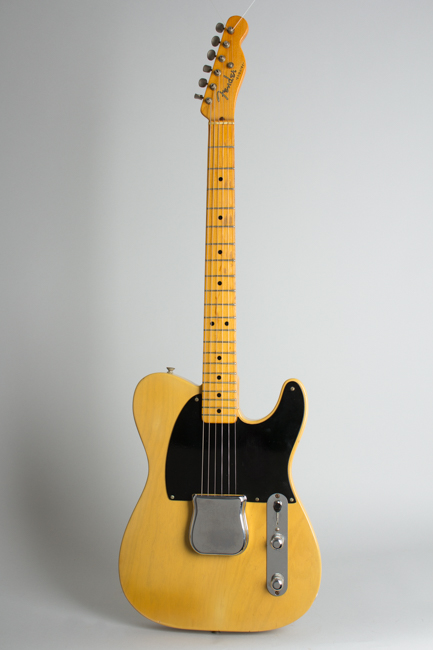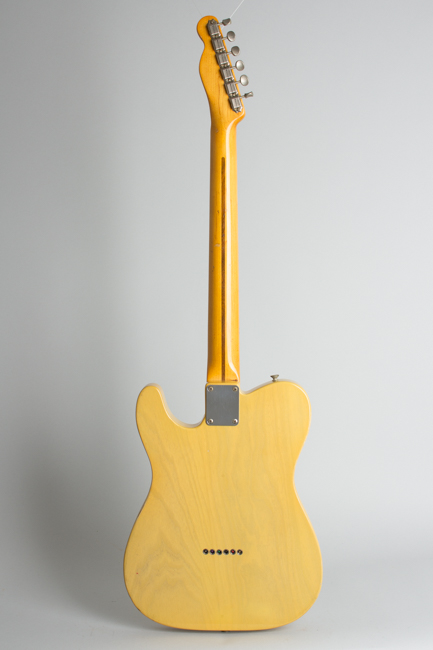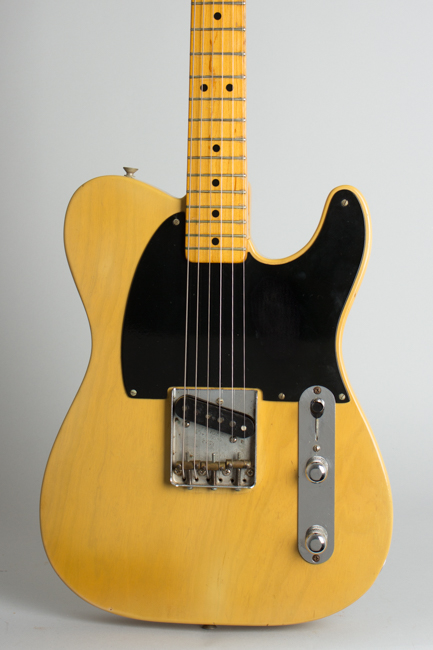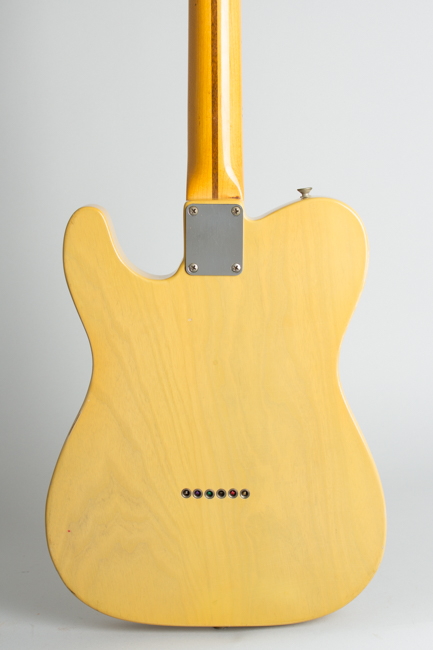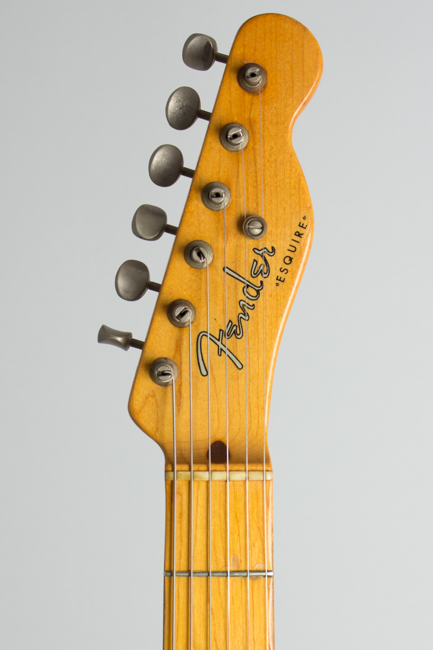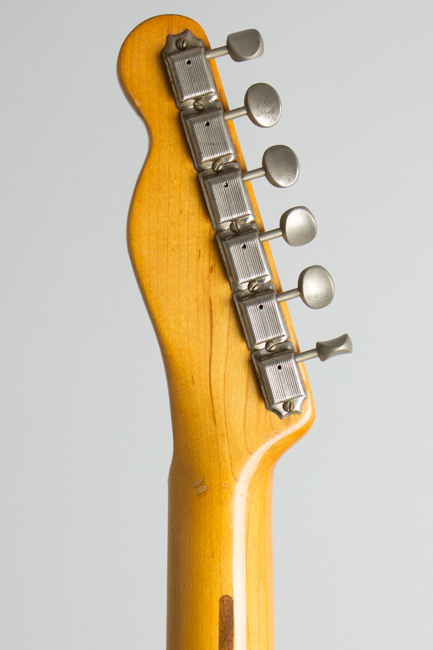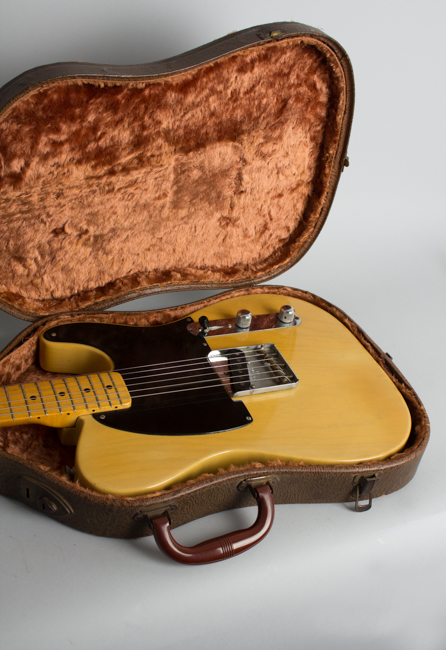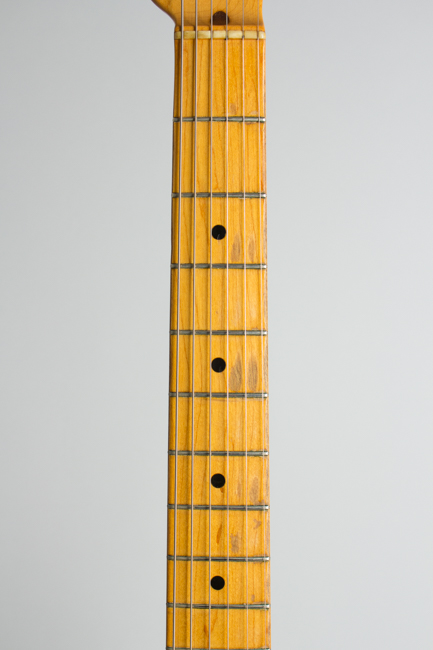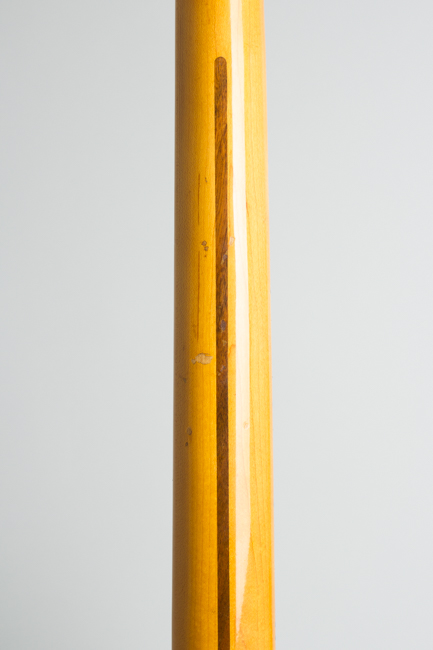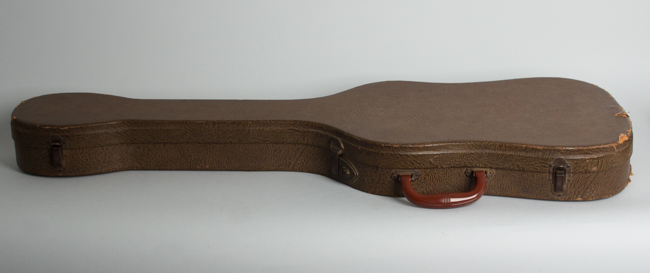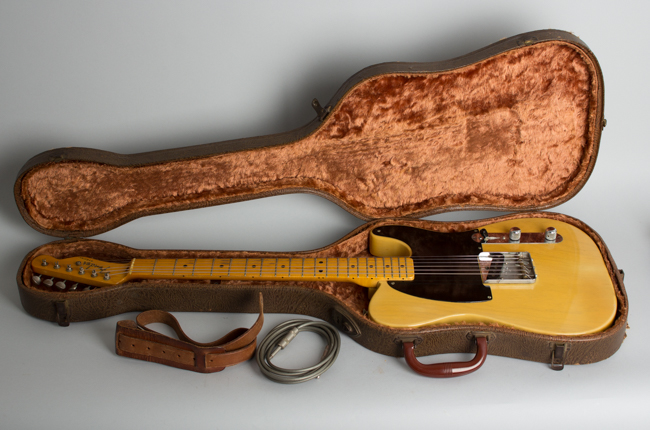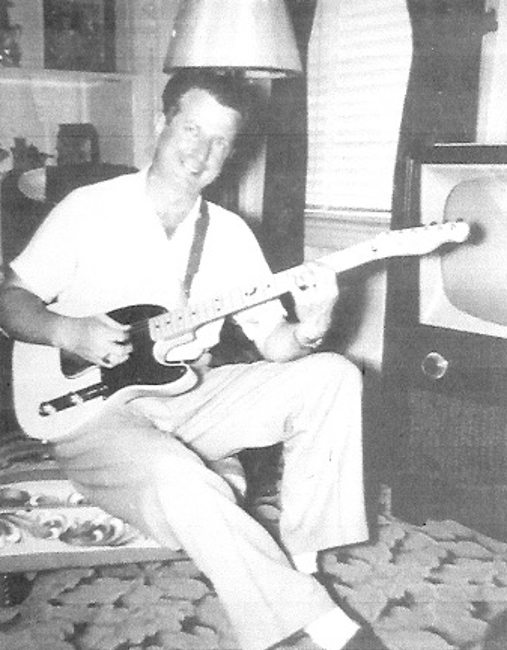Fender Esquire Solid Body Electric Guitar (1952)
This item has been sold.
Item # 8653
Prices subject to change without notice.
Fender Esquire Model Solid Body Electric Guitar (1952), made in Fullerton, California, serial # 2751, Blonde lacquer finish, ash body, maple neck, original brown shaped hard shell case.
This is a truly beautiful and amazingly well-preserved all-original "Blackguard" Fender Esquire, just in from the original owner's family. The Esquire and Telecaster are the guitars that put Leo Fender on the map for all time, and this is simply one of the nicest we have ever seen. This guitar was assembled at the company's old metal-shed factory in Fullerton, California as 1952 rolled into 1953. It has all the classic '52 Tele features: the one-piece maple neck, aged "butterscotch" blonde-finished ash body, lacquered black fiber pickguard, brass bridge saddles, and of course the original flat-pole bridge pickup with a sound for the ages!
This guitar carries the serial number 2751 stamped into the bridgeplate, with a neck date of 11-3-52 in pencil on the heel alongside the initials of Fender legend Taddeo Gomez. The body carries a date mark of 9-XX-52 in the neck cavity with Tadeo's name penciled in -- some of the date is not legible as it is covered by an old piece of masking tape. The "D" stamp into the wood commonly seen in 1952 is present as well. The potentiometer date codes are blue ink stamps showing the code "304" for Clarostat; one date marking is buried under a solder joint, but the other is 2-38, indicating the piece was made the 38th week of 1952.
This guitar has been played but extremely well cared for since it was shipped out in late 1952 or early '53, and recently resurfaced in Detroit, Michigan. Everything on this instrument is original, including the early "Esquire" wiring rig with its plethora of wax caps and resistors. The switch settings are a "deep bass" capacitor in position # 1; position #2 is the pickup in normal mode with the tone control engaged, and #3 is the pickup wired straight to the jack bypassing the tone control -- the "Esquire secret weapon" for the hottest tone setting on any old Fender.
The neck has a nice, round profile with a somewhat less chunky feel than models from earlier in the year. The screws are mixed flat and Phillips-head types as is customary for mid/late 1952; the truss rod adjustor is still a flat-head single slot, which is a late appearance for this Broadcaster-period feature but nonetheless original. For many, 1952 is THE classic Telecaster/Esquire year, with the same look and feel of the earliest Fender Broadcaster and "No-Caster" guitars from 1950-51, but more consistent production standards. Many of the fine details of the instrument continued to gradually evolve as the decade went along, but '52 is the benchmark year for comparison to all later Fender guitars, and the year Fender has generally selected for basing its re-issues on.
Before the introduction of the second Fender solid-body (the Stratocaster) in 1954, the Tele and Precision Bass were the company's most innovative and sensational products, and in 1952 were already causing a revolution in playing styles and shaking up the guitar world in a big way. At the time these guitars were totally unique in look, feel, and sound, and became instantly popular, particularly with country players. In the years since, many players and collectors have come to consider the 1952 Fender solid bodies the finest electric guitar ever made -- and one of the most historically important as well.
In his authoritative and beautiful book "The Blackguard", author Nachos Banos references this, calling '52s "a personal favorite" and stating, "The neck feel and lead pickup sounds from these ... make them some of the best Fenders ever made". The early "Blackguard" Fenders of this period are universally considered as one of the most collectible and historic of all electric guitars, and this is simply as fine and original an example as we have ever had.
Overall length is 38 3/4 in. (98.4 cm.), 12 3/4 in. (32.4 cm.) wide at lower bout, and 1 3/4 in. (4.4 cm.) in depth, measured at side of rim. Scale length is 25 1/2 in. (648 mm.). Width of nut is 1 5/8 in. (41 mm.).
This is simply a beautiful and completely original guitar -- nothing changed, modified or repaired in its nearly 70 years on the planet. The guitar has been played carefully over the years so there is minor wear to the edges of the body, the fingerboard, and a few random dings to the back of the neck. The lacquer shows some very light checking, and is not nearly as darkened and "smoked" as most we have had. There is a shallow wear spot to the lacquer on the pickguard from strumming.
The "ashtray" bridge cover is intact and shows the telltale solder mark on the underside from the early electroplating process used. The original "thermometer" case is still intact with some external wear and there are some tears to the cloth covering, mostly along the bottom edge. The original grey cable and a period "top grain leather" strap are included.
It almost goes without saying this is an exceptionally fine playing and sounding instrument, as virtually all of these are. This previously uncirculated guitar came to us straight from the original owner's family; "Pops" loved his Esquire, but we are told he never played it out of the house, and is pictured here smiling with it new in 1953. We hope the next owner feels the same way about this exceptionally fine early Fender. Excellent + Condition.
This is a truly beautiful and amazingly well-preserved all-original "Blackguard" Fender Esquire, just in from the original owner's family. The Esquire and Telecaster are the guitars that put Leo Fender on the map for all time, and this is simply one of the nicest we have ever seen. This guitar was assembled at the company's old metal-shed factory in Fullerton, California as 1952 rolled into 1953. It has all the classic '52 Tele features: the one-piece maple neck, aged "butterscotch" blonde-finished ash body, lacquered black fiber pickguard, brass bridge saddles, and of course the original flat-pole bridge pickup with a sound for the ages!
This guitar carries the serial number 2751 stamped into the bridgeplate, with a neck date of 11-3-52 in pencil on the heel alongside the initials of Fender legend Taddeo Gomez. The body carries a date mark of 9-XX-52 in the neck cavity with Tadeo's name penciled in -- some of the date is not legible as it is covered by an old piece of masking tape. The "D" stamp into the wood commonly seen in 1952 is present as well. The potentiometer date codes are blue ink stamps showing the code "304" for Clarostat; one date marking is buried under a solder joint, but the other is 2-38, indicating the piece was made the 38th week of 1952.
This guitar has been played but extremely well cared for since it was shipped out in late 1952 or early '53, and recently resurfaced in Detroit, Michigan. Everything on this instrument is original, including the early "Esquire" wiring rig with its plethora of wax caps and resistors. The switch settings are a "deep bass" capacitor in position # 1; position #2 is the pickup in normal mode with the tone control engaged, and #3 is the pickup wired straight to the jack bypassing the tone control -- the "Esquire secret weapon" for the hottest tone setting on any old Fender.
The neck has a nice, round profile with a somewhat less chunky feel than models from earlier in the year. The screws are mixed flat and Phillips-head types as is customary for mid/late 1952; the truss rod adjustor is still a flat-head single slot, which is a late appearance for this Broadcaster-period feature but nonetheless original. For many, 1952 is THE classic Telecaster/Esquire year, with the same look and feel of the earliest Fender Broadcaster and "No-Caster" guitars from 1950-51, but more consistent production standards. Many of the fine details of the instrument continued to gradually evolve as the decade went along, but '52 is the benchmark year for comparison to all later Fender guitars, and the year Fender has generally selected for basing its re-issues on.
Before the introduction of the second Fender solid-body (the Stratocaster) in 1954, the Tele and Precision Bass were the company's most innovative and sensational products, and in 1952 were already causing a revolution in playing styles and shaking up the guitar world in a big way. At the time these guitars were totally unique in look, feel, and sound, and became instantly popular, particularly with country players. In the years since, many players and collectors have come to consider the 1952 Fender solid bodies the finest electric guitar ever made -- and one of the most historically important as well.
In his authoritative and beautiful book "The Blackguard", author Nachos Banos references this, calling '52s "a personal favorite" and stating, "The neck feel and lead pickup sounds from these ... make them some of the best Fenders ever made". The early "Blackguard" Fenders of this period are universally considered as one of the most collectible and historic of all electric guitars, and this is simply as fine and original an example as we have ever had.
Overall length is 38 3/4 in. (98.4 cm.), 12 3/4 in. (32.4 cm.) wide at lower bout, and 1 3/4 in. (4.4 cm.) in depth, measured at side of rim. Scale length is 25 1/2 in. (648 mm.). Width of nut is 1 5/8 in. (41 mm.).
This is simply a beautiful and completely original guitar -- nothing changed, modified or repaired in its nearly 70 years on the planet. The guitar has been played carefully over the years so there is minor wear to the edges of the body, the fingerboard, and a few random dings to the back of the neck. The lacquer shows some very light checking, and is not nearly as darkened and "smoked" as most we have had. There is a shallow wear spot to the lacquer on the pickguard from strumming.
The "ashtray" bridge cover is intact and shows the telltale solder mark on the underside from the early electroplating process used. The original "thermometer" case is still intact with some external wear and there are some tears to the cloth covering, mostly along the bottom edge. The original grey cable and a period "top grain leather" strap are included.
It almost goes without saying this is an exceptionally fine playing and sounding instrument, as virtually all of these are. This previously uncirculated guitar came to us straight from the original owner's family; "Pops" loved his Esquire, but we are told he never played it out of the house, and is pictured here smiling with it new in 1953. We hope the next owner feels the same way about this exceptionally fine early Fender. Excellent + Condition.
